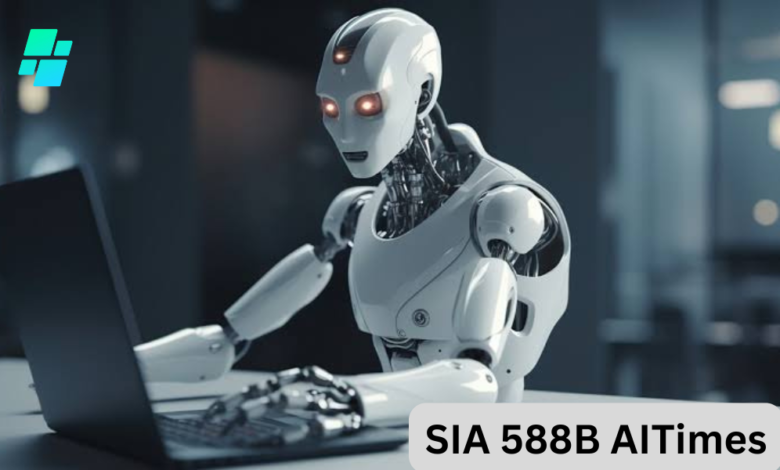1. What is SIA 588B?
SIA 588B is a cutting-edge AI model designed to push the sia 588b aitimes boundaries of machine learning, automation, and natural language processing. In simple terms, it’s a next-generation AI system created to manage complex tasks that require advanced problem-solving capabilities. SIA 588B represents a fusion of intelligent systems designed to streamline processes, improve efficiency, and perform operations that previously demanded human intervention.
The development of SIA 588B was driven by the need for smarter, faster, and more efficient AI systems. It’s structured to provide unparalleled support across industries, from finance and healthcare to robotics and beyond. Unlike earlier AI models, SIA 588B offers superior flexibility and adaptability, making it an ideal choice for dynamic environments where constant learning and evolution are necessary.
What makes SIA 588B truly revolutionary is its ability to handle large datasets and process information at unprecedented speeds. It offers deep-learning functionalities that allow it to “learn” from vast amounts of data, making it more intelligent over time. This adaptability and self-improvement mechanism put SIA 588B at the forefront of AI advancements.
2. History and Evolution of AI Times
AI Times refers to the period in which artificial intelligence moved from theoretical and experimental stages into practical and widespread applications. It has been a fascinating journey, with SIA 588B being one of the milestones along the way. Initially, AI development was slow due to limited computing power and inadequate data storage. But as technology advanced, so did AI models like SIA 588B.
The roots of AI can be traced back to the 1950s when early AI sia 588b aitimes theorists like Alan Turing and John McCarthy laid the groundwork for what would eventually become a massive technological movement. The introduction of machine learning in the 1980s and neural networks in the 1990s significantly accelerated AI development. By the time the 21st century rolled in, AI had become an essential tool for innovation, with AI Times marking the era of rapid breakthroughs.
SIA 588B emerged as a response to the limitations of earlier AI systems. AI Times saw a dramatic shift in how businesses and industries perceived artificial intelligence, with a focus on creating more efficient and self-reliant systems like SIA 588B. Its introduction in the early 2020s coincided with a surge in AI-driven automation, solidifying its place as a game-changer.
3. Technical Architecture of SIA 588B
At its core, the SIA 588B is built on a deep learning framework that leverages both supervised and unsupervised learning techniques. This enables it to understand and analyze complex data sets with minimal human intervention. The system employs a combination of neural networks, convolutional layers, and decision trees to achieve its intelligent outputs.
One of the most distinctive features of SIA 588B’s architecture sia 588b aitimes is its use of multi-layered neural networks. These networks mimic the human brain’s neural pathways, allowing the AI to perform intricate tasks such as pattern recognition, language translation, and predictive analytics. The model is highly scalable, meaning it can be applied to tasks of varying complexity without losing its efficiency.
Another key component of the technical architecture is its advanced data processing unit (DPU), which is designed to handle large-scale computational tasks. This processing unit ensures that SIA 588B can analyze massive datasets in real time, making it ideal for industries that rely heavily on big data, such as finance, healthcare, and retail. The incorporation of this advanced DPU is a key differentiator of SIA 588B, making it stand out from other AI models in its category.
4. Key Features and Specifications of SIA 588B
The unique selling point of SIA 588B is its combination of speed, efficiency, and adaptability. Below are some of the standout features that make SIA 588B a leading AI model in its class:
- High-Speed Data Processing: SIA 588B is capable of sia 588b aitimes processing data at lightning speed, which makes it perfect for real-time applications such as stock trading, autonomous driving, and predictive healthcare diagnostics.
- Self-Learning Capabilities: Through its use of deep learning algorithms, SIA 588B continually improves its performance. This means that over time, it becomes more efficient and accurate, a key benefit for industries that require constant evolution.
- Cross-Platform Integration: SIA 588B can be integrated into a wide variety of systems, including cloud-based environments, IoT devices, and traditional data centers. Its ability to seamlessly interact with multiple platforms is a testament to its versatility.
- Advanced Natural Language Processing (NLP): One of the most revolutionary aspects of SIA 588B is its ability to understand and generate human language at an advanced level. This makes it ideal for customer service bots, translation services, and other language-based applications.
These features make SIA 588B a highly valuable asset for any business looking to improve operational efficiency, reduce human error, and enhance decision-making processes.
5. SIA 588B’s Role in Artificial Intelligence Development
SIA 588B is not just another AI model; it’s a symbol of the rapid strides that artificial intelligence has made in recent years. Its introduction is a testament to how far AI has come since its inception, particularly in terms of machine learning, automation, and intelligent decision-making.
In the broader context of AI development, SIA 588B represents sia 588b aitimes a move toward more autonomous systems that can make decisions without needing constant human oversight. Early AI systems were largely rule-based, requiring extensive programming to function correctly. However, with the advent of machine learning, AI models like SIA 588B have become capable of learning from data and improving their performance over time.
By integrating self-learning capabilities into its architecture, SIA 588B has pushed the boundaries of what is possible with AI. Its role in the ongoing development of artificial intelligence cannot be overstated. It serves as a foundation for future AI systems, which will likely be even more advanced and capable of handling increasingly complex tasks with minimal human intervention.
6. Applications of SIA 588B Across Different Industries
SIA 588B has a wide range of applications across various industries. Its adaptability and versatility make it a valuable tool in sectors such as finance, healthcare, manufacturing, and even education. Below are some examples of how SIA 588B is transforming different industries:
- Finance: In the finance sector, SIA 588B is used for algorithmic trading, fraud detection, and risk management. Its ability to process data at high speeds allows financial institutions to make split-second decisions, which can be crucial in markets that fluctuate rapidly.
- Healthcare: SIA 588B is also making waves in the healthcare industry, where it is used for predictive diagnostics, drug discovery, and personalized treatment plans. Its ability to analyze large datasets in real time allows doctors and researchers to identify patterns and make more accurate diagnoses.
- Manufacturing: In the manufacturing sector, SIA 588B is used to optimize production lines, manage supply chains, and predict maintenance needs for machinery. Its use of machine learning algorithms enables it to foresee potential issues before they arise, reducing downtime and increasing overall efficiency.
- Education: Even in education, SIA 588B is finding a place. It can be used to create personalized learning plans for students, analyze educational trends, and even assist teachers in grading assignments through automation tools.
7. SIA 588B in Robotics: Redefining Automation
SIA 588B is playing a pivotal role in advancing robotics and redefining automation as we know it. Traditionally, robots were limited to pre-programmed tasks, but with SIA 588B’s intelligent learning capabilities, robots are becoming far more autonomous and capable of adapting to changing environments.
One of the most significant advancements brought about by SIA 588B in the field of robotics is its application in autonomous systems. Whether it’s self-driving cars, drones, or industrial robots, the model’s ability to process real-time data and make quick decisions makes it a perfect fit for applications that require high levels of precision and safety.
In industrial settings, SIA 588B-powered robots are transforming manufacturing floors by optimizing production lines and performing tasks with greater efficiency and accuracy. Robots equipped with SIA 588B can not only learn from their environments but also collaborate with human workers, creating a more integrated and efficient workforce.
8. How SIA 588B Impacts Machine Learning

Machine learning is at the heart of SIA 588B, and its impact on this field is both profound and far-reaching. With its ability to process and learn from large datasets, SIA 588B is significantly advancing the development of machine learning algorithms. Its self-improving mechanisms allow it to refine its decision-making processes without human intervention, which is a considerable leap forward in AI technology.
In supervised learning, SIA 588B uses labeled data to understand relationships and make predictions. However, its true strength lies in unsupervised learning, where it can identify patterns and insights from unstructured data. This capability is vital in industries such as retail, where understanding customer behavior from large volumes of data is essential for targeted marketing and improving customer experiences.
SIA 588B’s impact on machine learning doesn’t stop at data analysis. Its integration into neural networks and reinforcement learning algorithms has helped create AI systems that can “think” more like humans. These systems can make decisions based on real-time data and adjust their strategies as they learn, leading to smarter and more adaptable AI solutions.
9. SIA 588B in Natural Language Processing (NLP)
Natural language processing (NLP) has seen immense advancements, and SIA 588B is at the forefront of this evolution. NLP refers to the ability of AI systems to understand and generate human language. This technology is vital for applications such as voice assistants, chatbots, and language translation tools, where understanding context and sentiment is crucial for meaningful interactions.
SIA 588B takes NLP a step further by incorporating deep learning algorithms that enable it to grasp the nuances of human language, including idioms, slang, and even sarcasm. Its advanced NLP capabilities allow it to process text and voice data with a high level of accuracy, making it invaluable for businesses looking to improve customer service through chatbots and automated responses.
In addition to customer service applications, SIA 588B’s NLP functionality is being used in content generation, where it can create coherent and contextually accurate text. This is particularly useful in industries such as media and advertising, where personalized content can significantly boost engagement and brand loyalty.
10. SIA 588B and Its Use in Healthcare
The healthcare industry is one of the sectors most significantly impacted by SIA 588B. Its ability to process vast amounts of medical data in real time is revolutionizing how healthcare providers diagnose diseases, manage patient care, and even discover new treatments.
One of the primary uses of SIA 588B in healthcare is in predictive diagnostics. By analyzing patient data, such as medical history, symptoms, and test results, SIA 588B can help healthcare professionals predict the likelihood of certain conditions. This allows for early intervention and more personalized treatment plans.
Another exciting application of SIA 588B in healthcare is its use in drug discovery. Pharmaceutical companies can leverage SIA 588B to analyze the effects of various compounds on biological systems, significantly speeding up the process of finding new drugs. Additionally, the model’s ability to simulate outcomes can reduce the need for costly and time-consuming clinical trials, potentially saving lives in the process.
11. Security Concerns and Ethical Implications of SIA 588B
As with any advanced AI system, the introduction of SIA 588B raises several security and ethical concerns. One of the primary issues is data privacy. Since SIA 588B processes large amounts of data, there are concerns about how this data is stored, shared, and protected. Companies and governments must ensure that stringent data protection measures are in place to prevent breaches and misuse of sensitive information.
Another concern is the potential for bias in AI decision-making. While SIA 588B is designed to be as objective as possible, it still relies on data sets that could contain inherent biases. If not carefully managed, this could lead to unfair or discriminatory outcomes, particularly in sectors like hiring, law enforcement, and healthcare.
Ethically, the increasing reliance on AI systems like SIA 588B brings up questions about the role of human oversight. Should decisions that significantly impact people’s lives, such as medical diagnoses or legal judgments, be left in the hands of machines? It’s a debate that will likely intensify as AI continues to evolve.
12. Challenges Faced in the Adoption of SIA 588B
Despite its many advantages, the adoption of SIA 588B is not without its challenges. One of the most significant barriers is the cost of implementation. Developing and deploying advanced AI models requires substantial investment in both hardware and software. For smaller companies, the financial burden may be too great to bear, limiting the widespread use of SIA 588B.
Another challenge is the skill gap. Implementing and maintaining SIA 588B requires a high level of expertise in data science, machine learning, and AI. There is currently a shortage of professionals with the necessary skills to manage such advanced systems, which could slow down the rate of adoption.
Furthermore, there is the issue of regulatory hurdles. Many industries, such as healthcare and finance, are heavily regulated. Integrating SIA 588B into these industries requires compliance with strict regulations, which can be a time-consuming and costly process.
13. The Future of SIA 588B in AI Times
As we look to the future, SIA 588B is poised to become even more integrated into everyday life. Its ability to learn and adapt means that it will continue to improve, offering even more sophisticated solutions to complex problems.
In the future, we may see SIA 588B being used in more sectors, such as agriculture, where AI can be used to optimize crop yields and manage resources more efficiently. Similarly, in the energy sector, SIA 588B could be used to monitor and manage energy consumption, making it easier to transition to more sustainable energy sources.
Another exciting possibility is the development of even more advanced versions of SIA 588B. As AI technology continues to evolve, we may see new models that build upon the capabilities of SIA 588B, offering even greater performance and efficiency.
14. Comparative Analysis: SIA 588B vs Other AI Models
SIA 588B stands out from other AI models due to its speed, adaptability, and cross-platform integration. However, it’s worth comparing it to other well-known AI systems to understand its advantages and limitations better.
For instance, compared to GPT-4, SIA 588B excels in real-time data processing and autonomous decision-making. While GPT-4 is primarily focused on language understanding and generation, SIA 588B is designed to handle a broader range of tasks, including robotics, automation, and predictive analytics.
On the other hand, models like OpenAI’s DALL-E specialize in image generation, a feature that SIA 588B does not prioritize. Therefore, while SIA 588B is more versatile in practical applications, it may not perform as well in niche areas where other AI models are specifically designed to excel.
15. Conclusion: SIA 588B and the Road Ahead
In conclusion, SIA 588B represents a significant leap forward in AI technology. Its ability to process data at high speeds, learn from its environment, and integrate seamlessly with various systems makes it a valuable tool for industries across the board. However, as with any technology, it’s important to approach its adoption with caution, keeping in mind the ethical and security concerns that come with such powerful AI systems.
The future of SIA 588B is bright, and as AI continues to evolve, it’s likely that we will see even more innovative uses for this cutting-edge model. Whether it’s improving healthcare outcomes, optimizing industrial processes, or revolutionizing customer service, SIA 588B is poised to play a pivotal role in shaping the future of AI.
Frequently Asked Questions (FAQs)
1. What is SIA 588B? SIA 588B is a next-generation AI sia 588b aitimes model designed to manage complex tasks in areas such as machine learning, automation, and natural language processing. It offers self-learning capabilities and can process large datasets in real time.
2. How does SIA 588B compare to other AI models? Compared to other models like GPT-4, SIA 588B excels in real-time data processing and autonomous decision-making, making it more versatile for various practical applications across industries.
3. What industries can benefit from SIA 588B? SIA 588B is applicable in numerous industries, including healthcare, finance, manufacturing, and even education, where it can optimize processes, improve decision-making, and enhance efficiency.
4. What are the ethical concerns surrounding SIA 588B? The main ethical concerns include data privacy, the potential for bias in decision-making, and the need for human oversight in critical areas like healthcare and law enforcement.
5. Can small businesses afford to implement SIA 588B? The cost of implementation can be a challenge for smaller companies, but as AI technology becomes more accessible, the barriers to entry may decrease over time.
6. What is the future of SIA 588B? SIA 588B is expected to continue evolving, with more advanced versions likely to emerge. Its future applications could span new sectors such as agriculture and energy management, where AI can help optimize processes.



